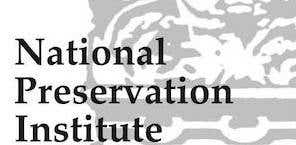
News
National Preservation Institute (NPI) Training Seminars
National Preservation Institute
February – November 2020
Professional Training Seminars in Historic Preservation & Cultural Resource Management
The National Preservation Institute, a nonprofit 501(c)(3) organization founded in 1980, educates those involved in the management, preservation, and stewardship of cultural heritage. Continuing education training seminars bring distinguished faculty to highlight state-of-the-art practice in important areas of historic preservation and cultural resource management. Training seminars focus on enhancing the skills of professionals responsible for the identification, evaluation, planning, management, preservation, and protection of cultural resources. Case studies and small group exercises focus on the information, technology, and skills that effective managers require in today’s changing preservation environment. NPI can provide customized on-site training to meet specific organizational needs.
Seminar Descriptions
■ Conflict Management and Negotiation Skills for Cultural and Natural Resource Managers Laws and regulations related to cultural and natural resources often require participatory processes that can be mired in conflict and misunderstanding. Projects frequently can be more effectively navigated when stakeholders use collaborative processes and mutual gains negotiation during consultation to resolve problems and develop win-win solutions. Through interactive exercises and role plays, learn to understand conflict management styles, practice negotiation skills, and design a stakeholder consultation process to address issues in a timely manner and prevent conflict from escalating. Faculty: Tanya Denckla Cobb
■ Cultural and Natural Resources: An Integrated Management Strategy Explore a holistic stewardship approach to an integrated management strategy for cultural and natural resources on public and private lands. These resources often are analyzed and planned for independently, leading to isolated approaches. Through case studies, discuss and evaluate long-term planning and decisionmaking processes that combine legal and management frameworks to better conserve and preserve the core values of these resources. Faculty: Claudia Nissley
■ Emerging Technologies for Cultural Resources Review best means of integrating new technologies with existing CRM practices as they relate to the documentation, preservation, and/or creative mitigation of cultural resources. Learn about the use of unmanned aerial vehicles (UAVs or drones), digital documentation (photogrammetry), and virtual reality (new media methods). Discuss ways to integrate these technologies with more familiar forms of technology, such as geographic information systems (GIS), and explore how information gathered can be used for public outreach. Faculty: Luke J. Pecoraro, Ph.D.
■ GIS for Cultural Resources: An Introduction Discuss introductory geographic information system (GIS) concepts and functionality, combining spatial technologies and database management systems in the area of historic preservation. Learn how to use GIS software through hands-on exercises for identification, evaluation, protection, and preservation of cultural resources. From assisting with inventories, to mapping historic districts and battlefields, to mitigating the impact of disasters on historic areas, GIS technology can be used to provide a better basis for planning and decisionmaking for the nation’s heritage. Faculty: Deidre McCarthy, GISP
■ GIS for Cultural Resources: Advanced Techniques Review how to use geographic information system (GIS) technology for applications that go beyond the basics for identification, evaluation, protection, and preservation of cultural resources. From geo referencing historic maps to publishing data online, looking at the latest data sources/ types, and producing story maps, there are many innovative ways to use GIS technology to expand the resources available to professionals and the general public. Faculty: Deidre McCarthy, GISP
■ Historic Property Management Historic property management combines preservation maintenance with modern systems management. Learn how to read your building, search for solutions, and then care for the building envelope by maintaining its historic materials. Explore how to balance the environmental needs of the building with its users. Understand the impacts on historic properties of pest management practices and mechanical building systems—HVAC, plumbing, fire, security, and lighting. Discuss how to train in-house staff and when to hire a specialist to identify a problem or a contractor to handle a specific task. Faculty: Ernest A. Conrad, P.E., LEED AP, CEM and Alfonso A. Narvaez
■ HSRs and Maintenance Plans: Tools for Preservation Review the core planning tools used for the preservation of historic properties and for quality project management. Accurate knowledge about the building is an essential first step. Explore the historic structures report—the principal tool used to document a building’s history, condition, and maintenance. Discuss the use of maintenance plans for scheduling daily, monthly, and annual activities. Faculty: Alfonso A. Narvaez
■ Landscape Preservation: An Introduction In this introduction to the basics of cultural landscapes, learn about designed, vernacular, and ethnographic landscapes, and historic sites. Review applicable laws and regulations, and discuss how to identify and inventory character-defining features of a landscape. Explore the concepts of preservation planning and documentation, and the development of the cultural landscape report for use in managing historic and cultural landscapes. Case studies illustrate realistic approaches to effective landscape management and preservation. Faculty: Lucinda A. Brockway or Nancy J. Brown, FASLA
■ Landscape Preservation: Advanced Tools for Managing Change In this advanced landscape preservation seminar, explore the sometimes conflicting issues that direct the process of change and decisionmaking for challenging landscapes. Review the practice and discuss the implications of inventorying, evaluating, treating, and maintaining landscape resources. Identify tools and techniques for managing change when difficult issues affect the process. Understand the philosophical foundations for making sound, educated decisions about the preservation and longterm management of historic and cultural landscapes. Faculty: Lucinda A. Brockway or Nancy J. Brown, FASLA
■ NAGPRA and ARPA: Applications and Requirements Review the historical context and intent of the Native American Graves Protection and Repatriation Act (NAGPRA) and the Archaeological Resources Protection Act (ARPA). Learn how these laws apply to the treatment, repatriation, and disposition of Native American cultural items and to the protection of archaeological resources on federal and tribal lands. Examine differences in legal definitions, when and how regulations apply, and permit requirements. Discuss practical applications and effective strategies for developing agreements prior to ground-disturbing actions. Faculty: Claudia Nissley
■ NAGPRA Essentials Review the compliance process for the Native American Graves Protection and Repatriation Act (NAGPRA) for Indian tribes, Native Hawaiian organizations, federal agencies, and museums. Explore how consultation can inform inventories, summaries, and cultural affiliation, and the resulting notices, repatriations, and dispositions. Faculty: Jan I. Bernstein and/or Megon Noble or Eric Hemenway
■ Native American Cultural Property Law Review the federal laws intended to preserve Native American heritage through the protection of cultural practices and sacred lands. Examine the use of statutes as tools to manage tangible and intangible cultural property. Discuss government-togovernment obligations, court decisions, and case studies to illustrate federal policies and practice. Consider the legal, cultural, and historical perspectives resulting from decisions affecting Native American cultural property. Learn how the consultation process enables tribes, federal entities, and other parties to achieve resolution. Faculty: Claudia Nissley
■ NEPA Compliance and Cultural Resources Gain a basic understanding of the National Environmental Policy Act and the NEPA process. Learn to identify cultural resources in context and examine the requirements for their consideration within the NEPA regulations. Discuss how to incorporate cultural impact assessments into environmental impact statements, environmental assessments, and categorical exclusions. Assess practical applications for effectively integrating the analyses required by NEPA with other regulations. Faculty: Claudia Nissley
■ The Recent Past: Strategies for Evaluation Examine nationwide trends in mid-20th-century houses and neighborhoods, with an emphasis on the evaluation of large suburban developments, construction methods, and house types and plans. Review era-specific factors that help to identify and categorize these buildings. Evaluate survey methodologies and consider the impact of neighborhood zoning, subdivision design review, urban renewal, and owner associations. Discuss how to determine the significance and integrity of resources when evaluating eligibility for federal and state programs, such as the National Register and the Secretary of the Interior’s Standards. Faculty: James C. Massey, Assoc. AIA
■ Risk Assessment and Resiliency Planning for Cultural Resources Examine the increasing threats and challenges that cultural resources face from environmental changes. Learn how to use the risk assessment process to evaluate, prioritize, and plan for continued sustainability. Discuss management goals, redundancy systems, and mitigation strategies. Consider ways to build strategic partnerships to help integrate cultural resources into local and regional planning. Explore the resiliencyplanning process through case studies and during group exercises. Faculty: Ellen Rebecca Hartman, Paul Loechl, and/or Adam Smith
■ The Secretary of the Interior’s Standards: An Overview The Secretary of the Interior’s Standards for the Treatment of Historic Properties form the basis for work on historic properties, including all federal undertakings, federal tax benefits, and, often, state, local, and private projects. Explore the Standards in detail, with particular attention to identifying significance and determining appropriate preservation strategies for historic fabric. Explore the topics of accessibility, building codes, fire protection, resiliency, security, and sustainability that may impact decisionmaking. Through hands-on exercises, participants learn how to apply the Standards to their projects. Faculty: Judith Capen, R.A. or John J. Cullinane, AIA
■ Section 4(f) Compliance for Historic Properties Section 4(f) of the DOT Act of 1966 is triggered by funding or approval from a U.S. DOT agency for a project that proposes “use” of historic property or land from a publicly owned park, recreation area, or refuge. With a focus on historic properties, examine the stringent approval standards of this substantive law and discuss ways to better integrate and streamline Sections 4(f) and 106 with the National Environmental Policy Act (NEPA) process. Faculty: MaryAnn Naber
■ Section 106: An Introduction Learn the basics of project review under Section 106 of the National Historic Preservation Act. This seminar emphasizes practicalities—how to avoid pitfalls and victimization by myths. Discuss recent changes in regulations and procedures, with an emphasis on coordination with the National Environmental Policy Act and other laws. Faculty: Allyson Brooks, Ph.D., Ethel R. Eaton, Ph.D., MaryAnn Naber, or Claudia Nissley
■ Section 106: A Review for Experienced Practitioners Review regulations, standards, guidelines and related laws relevant to Section 106 review. Discuss issues, problems, and “tricks of the trade,” with an emphasis on ways to employ creativity and flexibility to reduce complexity and improve effectiveness. Faculty: Claudia Nissley
■ Section 106: Agreement Documents This advanced seminar focuses on memoranda of agreement and programmatic agreements under Section 106 of the National Historic Preservation Act. Learn how to survive and thrive during the agreement process through careful analysis, clear writing, and good negotiation. Review the available tools, guidelines, alternatives—and non-alternatives—to reach a favorable conclusion to the process. Faculty: Ethel R. Eaton, Ph.D. or Claudia Nissley
■ Traditional Cultural Places “Traditional cultural places” (TCPs) play an important role in community cultural traditions, beliefs, and activities. TCPs must be considered in planning under the National Environmental Policy Act, the National Historic Preservation Act, Executive Orders 12898 and 13007, and other authorities. Review methods of identifying TCPs, discuss evaluation for National Register eligibility, and explore management issues. Faculty: Claudia Nissley
Learn more at NPI.org.









